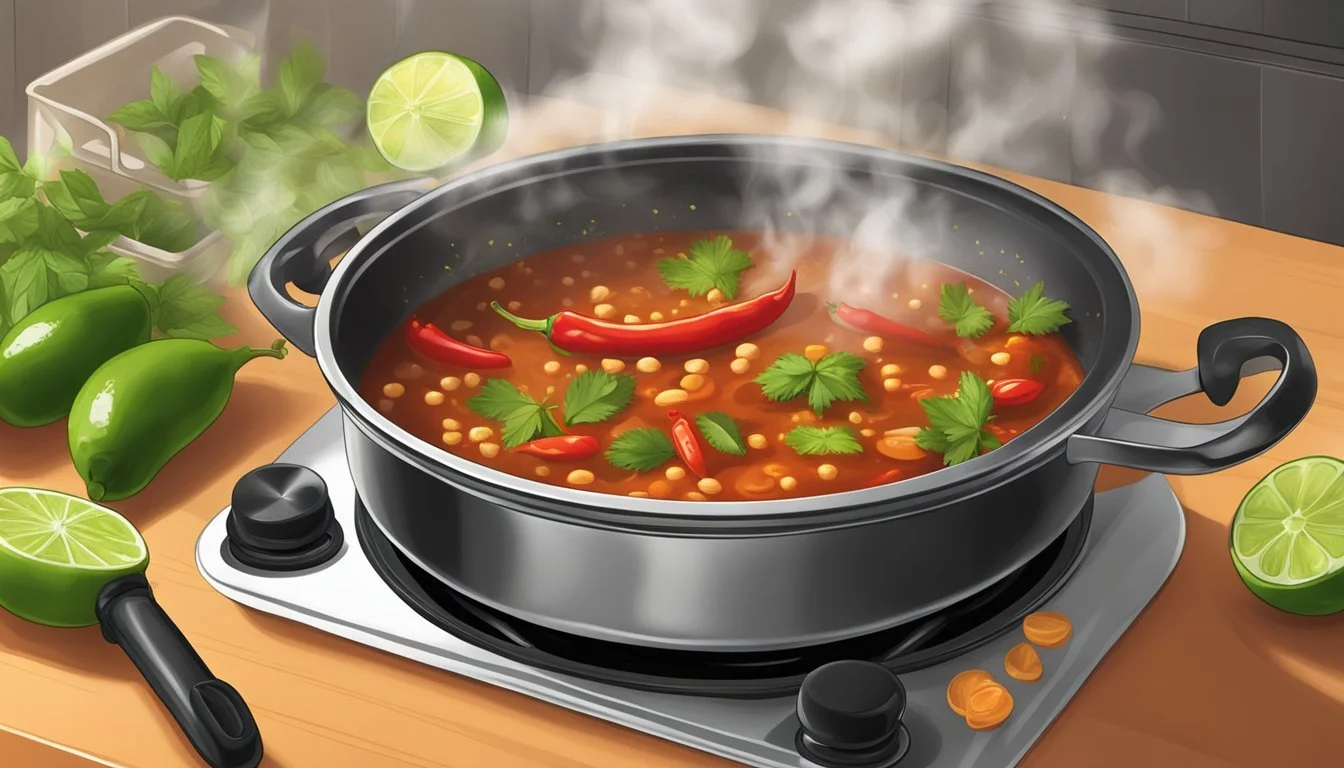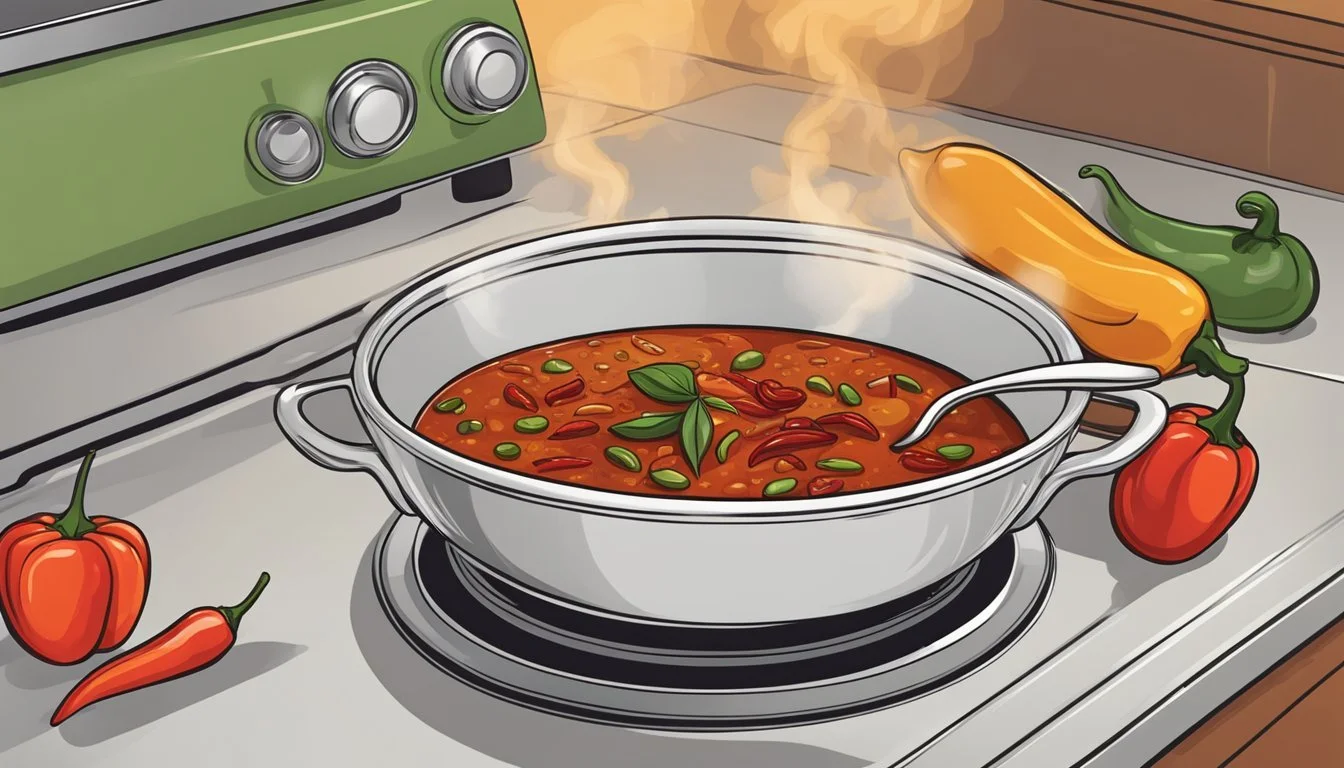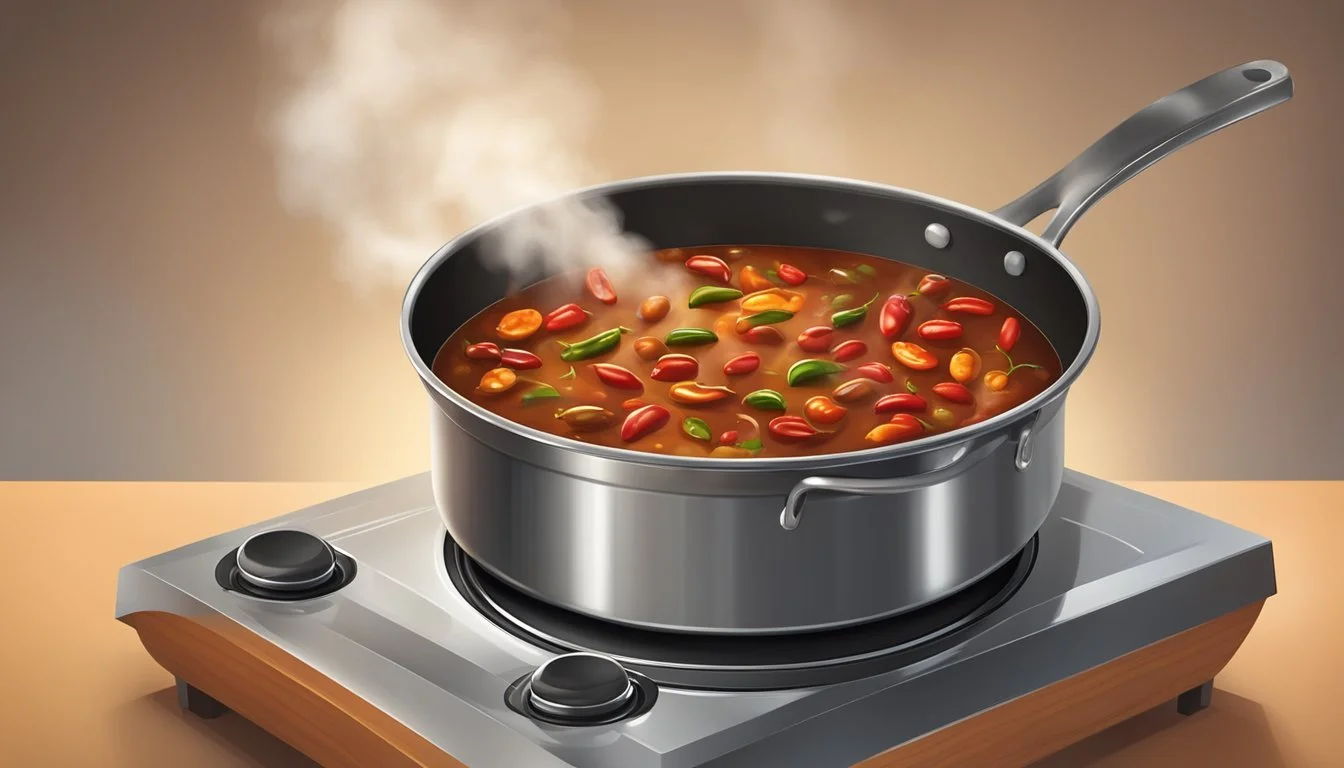Best Way to Reheat Chili
Tips for Flavorful, Perfectly Warmed Meals
Chili is a dish that often tastes better the next day after the flavors have had time to meld together. However, reheating it properly is crucial to retaining its robust flavors and ensuring it is just as satisfying as when it was freshly made. With a few expert tips, chili can be warmed up to bring out its best qualities without compromising texture or taste.
The key to successfully reheating chili lies in choosing the right method that not only heats the food thoroughly but also enhances its inherent flavors. Whether a person opts for the oven, stove, or microwave, there are specific techniques to follow for optimum results. For instance, heating chili slowly and evenly in the oven or on the stove can prevent it from drying out, while adding a touch of water or broth can maintain its moisture and consistency.
When reheating in the microwave, a careful approach is essential. Covering the chili with a microwave-safe lid or plastic wrap can minimize splatter while allowing steam to circulate, ensuring the chili warms evenly. Stirring halfway through heating helps distribute heat throughout the dish. Regardless of the heating method, it is important to bring the chili to an internal temperature of at least 165°F (74°C) as a food safety standard, guaranteeing that the reheated chili will be both safe to eat and delicious.
Understanding Chili Properties
The successful reheating of chili hinges on recognizing how its texture, flavor, and safety can be influenced by storage and reheating methods.
Chili Texture and Components
Chili is a combination of beans, tender meats, and often peppers, enveloped in a rich, thick sauce. To maintain the distinct texture of the beans and the tenderness of the meats, gentle reheating is crucial. Overheating can lead to the beans becoming mushy and the meats toughening up.
Flavor Preservation
Flavor in chili comes chiefly from spices and seasonings that have melded over time. When reheating, it's important to do so gently to preserve these complex flavors. A saucepan is often the preferred method for gently warming leftover chili, allowing for stirring to distribute heat without degrading the taste.
Food Safety Considerations
Food safety for leftover chili is paramount to prevent foodborne illness. When storing chili, either in the refrigerator or before you freeze it, ensure it's in airtight containers. To thaw frozen chili, shift it to the refrigerator overnight rather than at room temperature to inhibit bacterial growth.
Storage Insights
Chili's constitution makes it apt for storage as leftovers. In the refrigerator, cover leftover chili with aluminum foil or store in airtight containers to retain moisture and flavor. Chili should typically not be kept in the refrigerator for more than three to four days. If frozen, ensure it's defrosted correctly and consumed within a reasonable timeframe to maintain both quality and food safety.
Preparation For Reheating
Prior to reheating chili, thorough preparation ensures the flavor and safety of the dish are maintained. Correctly thawing and managing the chili's temperature, as well as adding moisture before reheating, are crucial steps in this process.
Thawing and Temperature Management
If the chili has been frozen, it's important to thaw it properly to preserve its quality. Transfer the chili from the freezer to the refrigerator and allow it to thaw overnight. This method ensures that the chili remains at a safe temperature to prevent the growth of harmful bacteria. Once thawed or if refrigerated, the chili should be brought to room temperature for even heating. A food thermometer can be used to ensure that during reheating, the chili reaches an internal temperature of at least 165°F (74°C) to ensure it is safe for consumption.
Adding Moisture Before Reheating
Reheated chili can lose moisture and become dry, affecting both texture and flavor. To counter this, add moisture to the chili before heating. For each cup of chili, stir in one tablespoon of water or broth. This small addition helps to keep the chili moist and enhances the flavors. The broth can also add a layer of depth to the chili's taste profile, while water is a neutral option that will not alter the flavor composition already present in the dish.
Reheating on the Stovetop
Reheating chili on the stovetop is a favored method for preserving its flavors and texture. It allows for precise heat control and even distribution.
Stovetop Method Steps
To reheat chili on the stove, one should use a pot that is suitable for the amount of chili being warmed up. The individual should follow these specific steps:
Heat the pot: Place the pot on the stovetop and turn the heat to a low setting.
Add chili: Spoon the desired amount of chili into the pot.
Add liquid: Pour a small amount of water or broth into the pot to help return moisture to the chili.
Increase temperature: Gradually regulate the temperature from low to medium heat.
Stirring and Simmer Techniques
For best results when reheating chili on the stovetop, one must engage in consistent stirring and simmering:
Stirring occasionally: With a spatula or spoon, stir the chili every few minutes to prevent sticking and to ensure an even distribution of heat.
Simmering: After the initial stirring, let the chili simmer on low heat. This gentle cooking process enhances flavors without reducing the chili to an undesirable texture.
A taste test is recommended to ensure that the chili has reached the desired temperature and taste. The target temperature for food safety purposes is at least 165°F (74°C). After reaching this internal temperature, it should be removed from the heat to prevent overheating, which may affect the chili's flavor and texture.
Reheating in the Microwave
When reheating chili in the microwave, attention to detail is key for preserving its flavors and texture. A microwave can quickly and evenly reheat chili if proper guidelines are followed and overcooking is avoided.
Microwave Method Guidelines
Preparation: Transfer the chili to a microwave-safe bowl or container. If the chili appears dry, add a tablespoon of water or broth.
Covering: Place a microwave-safe lid or cover loosely with microwave-safe plastic wrap to contain moisture and prevent splattering. Poke a few holes in the plastic wrap for ventilation.
Heat Settings: Reheat the chili using high power in short intervals, typically 30 seconds.
Stirring: After each interval, remove the bowl carefully with heat-protective mitts and stir the chili to promote even reheating.
Temperature Check: Continue the process until the chili reaches an internal temperature of 165°F, using a food thermometer to ensure safety.
Avoiding Overcooking
Short Intervals: Utilizing shorter heating times allows for checking the chili frequently, which is crucial to prevent overcooking.
Stirring: Each time the chili is stirred, it helps in assessing the heat distribution and the overall consistency of the chili.
Final Resting: Once the desired temperature is reached, let the chili stand for a minute in the microwave. This helps the heat to distribute evenly through residual cooking.
By following these specific steps, reheating chili in the microwave can be a quick and effective method, preserving its taste and quality.
Reheating in the Oven
Reheating chili in the oven can preserve its flavor and texture when done correctly. This section guides readers through the oven method, focusing on both technique and tips for maintaining chili's moisture and flavor during reheating.
Oven Method Overview
To reheat chili in the oven, one starts by preheating the oven. The ideal temperature is typically around 325°F to 350°F (163°C to 177°C). The chili should be placed into an oven-safe dish. The use of an oven method ensures a slow and gentle reheating process, reducing the risk of burning or drying out the chili.
Preheat Oven: Set your oven to a moderate temperature.
Prepare Dish: Transfer chili to an oven-safe dish and spread evenly.
Cover: Seal the dish with aluminum foil or a compatible lid to keep the chili moist.
It's crucial to check the chili periodically, stirring occasionally for even heat distribution. The general guideline is about 20-30 minutes for heating, but larger portions may require up to 45 minutes.
Maintaining Moisture and Flavor
When reheating chili in the oven, maintaining its moisture and flavor is paramount. Here's how one can achieve that:
Add Liquid: Before heating, add a small amount of water or broth to the chili to replenish any lost moisture during storage.
Cover Tightly: Use aluminum foil to cover the dish tightly. This prevents moisture loss and helps to evenly distribute heat.
Chili should reach an internal temperature of 165°F/74°C to ensure it is safe for consumption. Taste testing after reheating can help ensure the flavor has been preserved and the chili is at the desired serving temperature.
Enhancing and Maintaining Flavor
The key to enhancing and maintaining flavor when reheating chili is to make smart seasoning adjustments and conduct taste tests during the process. This ensures that the texture, acidity, and flavors remain as vibrant as when the chili was first prepared.
Seasoning Adjustments
When reheating chili, one may need to add additional ingredients to compensate for flavor loss. Acidity often diminishes, so introducing a small amount of vinegar can revive the taste. A teaspoon of balsamic vinegar, for example, can enhance the overall flavor profile without overwhelming the dish. It is important to be mindful of the balance between spices and other elements such as salt to preserve the chili's intended flavor.
Adjust Spices: If the chili tastes bland, a pinch of fresh spices may be necessary.
Add a small amount of cumin or chili powder to intensify smokiness.
Incorporate a dash of paprika for a subtle sweetness.
Incorporate Freshness: Adding fresh herbs (how long do fresh herbs last?) or a squirt of lime can brighten the chili.
Taste Testing During Reheating
Taste testing at intervals during reheating is crucial for flavor preservation. As the chili heats up, flavors can change, and adjustments may be required.
Initial Taste Test: Before adding any new ingredients, assess the current state of the chili.
Continuous Monitoring: As the chili reheats, stir and taste periodically.
Final Taste Test: Ensure the desired flavor is achieved before serving.
Assess texture and flavor; add a touch of water or broth if the chili has thickened excessively.
Evaluate the impact of additional ingredients on overall taste; less is often more to maintain the chili's original character.
By attentively adjusting seasonings and performing taste tests during reheating, one can serve a bowl of chili that is as flavorful and enticing as when it was freshly made.
Additional Tips for Best Results
To ensure the reheating of chili amplifies its flavors, one must consider both the introduction of complementary ingredients and the effective use of kitchen gadgets.
Incorporating New Ingredients
When reheating chili, the addition of fresh components can both rejuvenate and elevate the dish. For instance, incorporating small cubes of roasted squash or sweet potato can introduce a subtle sweetness that contrasts well with the savoriness of the chili. It is vital, however, to add such ingredients carefully to maintain the dish's balance – typically a tablespoon per serving suffices.
Squash: Gently stir in roasted butternut squash (how long does butternut squash last?) cubes during the last few minutes of reheating.
Sweet Potato: Mix in a handful of sweet potato pieces to infuse a natural, earthy sweetness.
Utilizing Kitchen Gadgets
Maximizing the potential of kitchen gadgets like the Instant Pot can streamline the reheating process while enhancing the chili's texture and flavor.
Instant Pot: Use the 'Saute' feature to gradually warm the chili, occasionally stirring. For larger quantities, the 'Keep Warm' mode can effectively maintain the temperature after reheating without overcooking.
By leveraging these additional ingredients and taking advantage of modern kitchen appliances, one can profoundly improve the quality of reheated chili while adding nuanced flavors and maintaining an ideal consistency.
Serving Chili After Reheating
Once chili is reheated to the right temperature, the key to serving is pairing it with the perfect garnishes and ensuring it's enjoyed at a temperature that brings out its flavors but does not risk diner comfort.
Optimal Serving Temperature
Chili should be served at an internal temperature of around 165°F - 170°F. This is the temperature that is not only safe but also keeps the flavors robust without diminishing the texture of the chili. Use a food thermometer to check the temperature before serving to ensure safety and quality.
Garnishes and Toppings
When it comes to enhancing the reheated chili's flavors, garnishes and toppings are crucial. A variety of toppings can be offered on the side to let each person customize their bowl:
Sour Cream: A dollop adds a cool, creamy texture and can help balance the heat from the chili's spices.
Shredded Cheese: Whether it's sharp cheddar or a milder Monterey Jack, cheese brings a rich and tangy flavor that melds with the chili.
Cilantro: Fresh cilantro leaves can brighten up the dish with a pop of color and a refreshing taste.
Avocado: Offering slices or cubes of avocado adds a buttery texture and can be a hearty addition.
Make sure these toppings are prepared fresh, and they're presented in a way that's easy for guests to add to their chili. Each garnish should be offered in separate bowls with serving spoons to keep things hygienic and organized.
Frequently Asked Questions
Can you reheat chili more than once?
It's generally safe to reheat chili multiple times as long as it's done correctly. However, to maintain quality and food safety, they should ensure it reaches 165°F each time and limit the reheating cycles.
Should you add liquid when reheating chili?
Adding a small amount of liquid, such as water or broth, can help maintain the chili’s moisture during the reheating process.
How to prevent chili from drying out during reheating?
Covering the chili with a lid or aluminum foil when reheating in the oven or using a microwave-safe cover can help retain moisture.
Can you freeze chili?
Absolutely! Chili freezes well. They should let it cool completely, use airtight containers or bags, and consume within 4-6 months for best quality.
Method Notes Oven 325°F-350°F for 20-30 minutes covered, stirring occasionally. Microwave Short intervals with stirring, cover to minimize splatter. Stovetop Medium heat, stir frequently, add liquid if needed.
Best practices to maintain flavor when reheating?
Gradual reheating at medium temperatures and adding fresh herbs or spices can enhance flavors that may have diminished during storage.
Conclusion
Reheating chili effectively preserves moisture and enhances flavor. Microwave usage offers quick heating, while stirring ensures even warmth. Oven reheating at 325°F to 350°F with added liquid under a cover provides thorough warmth for both thawed and frozen chili. Low heat on the stovetop with occasional stirring prevents burning and evenly heats the dish. Incorporating extra water or broth helps maintain the chili's consistency. Each method should attain a minimum temperature of 165°F for safety. A rested chili often features intensified flavors due to ingredient melding overnight. These reheating techniques ensure a delicious and savory chili experience upon serving.






